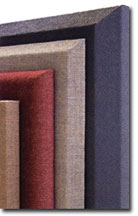Educational Acoustics/Acoustics 101
Acoustics is not as hard as people generally make it out to be. Reverberation (echo) is simply a relationship between the size of the space and the surfaces that make up the space. The intent of this article is to help you start to understand how that relationship works and how to help or eliminate an echo problem.
Please keep in mind that if you would like to discuss your specific situation please feel free to contact me via phone or E-mail which are at the bottom. I have a background and degree in educatio, K12 Art to be specific. Although I am not currently teaching, I have a good idea where you are coming from. I know that you do not have time to sit down and study sound and how it works. I would like to try to make it simple, so here goes.
- How many panels do I need?
The answer to this question depends on how quiet you need the space which ultimately up to you, but here is a place to start. This equation was developed as an average – a starting point to figure out hoe many acoustical panels needed per room.
Multiply the room dimensions:
Height x width x depth, then multiply that number by 3%.
The number that you end up with is approximate total square feet of paneling needed for your room.
Example: If your classroom is 25′ wide, 45′ deep and has 10′ tall ceilings, your equation would look like this:
25 x 45 x 10 = 11,250 cubic feet of volume
11,250 x .03 = 337.5
This room needs approximately 337.5 square feet of panels.
- Where should the panels be installed?
Put the panels wherever you want. Most commonly, acoustical panels are put on the walls near the ceiling. Keeping the panels out of the reach of children will greatly extend their life, as I am sure you can imagine. Acoustically speaking, a room with 45 acoustical panels placed evenly on all four walls will sound exactly the same as an identical room with the same 45 panels placed on the ceiling, or on the floor for that matter. Echo control is done with quantity, not placement.
The products below are the three most common acoustical treatments sold to schools – the Echo Eliminator being the most popular simply due to cost. I will explain the pros and cons of each, as well as giving a ballpark price for each. Please do not rely on this document as a quote, call me if you need a quote or have any questions.
Cost: 1″ thickness $4.00 per square foot/2″ thickness: $5.50 per square foot
Pros: Extremely cost effective, very absorbent, 100% recycled cotton fiber, light weight, class A/1 Fire rated, easy to install, cost effective to ship, nine different colors, fiberglass free
Cons: Does not look as finished as other panels, is not considered “cleanable”, size limited to 2′ x 4′ panels.


Cost: 1″ thickness $5.50 per square foot/2″ thickness: $7.50 per square foot
Pros: Cleanable, tack-able, light weight, water and impact resistant, cost effective to ship, class A/1 Fire rated, non-fibrous, in-stock
Cons: Not as acoustically absorbent as some other panels, fairly costly, limited number of colors, size limited to 2′ x 4′ panels

Cost: 1″ thickness, approx. $6.50 per square foot/2″ approx. $12.00 per square foot
Pros: Very acoustically absorbent, panel sizes customizable, great color selection, four different edge options, Class A/1 Fire rated
Cons: Costly, lead time is between one-and-three weeks, shipping only via LTL on a pallet





